Holding Your Team to High Standards – Transcript
transcript
Holding Your Team to High Standards
Here to read instead of watch? Click through the headings to a section of the full transcript, or scroll away!
- Low Standards Are Dangerous
- This Webinar Assumes That...
- The 3 Common Pitfalls Managers Find Themselves in
- Fidelity (with Examples!)
- Severity (with Examples!)
- Neglect (with Examples!)
- Where you Want to be – Justice & Love (with Examples!)
- The Standards Devotion Matrix
- How to Get Out of Being Stuck in Severity
- Using Inquiry to Increase Devotion (with Examples!)
- Using Positive Reinforcement to Increase Devotion (with Examples!)
- What if Your Team Member does Everything Wrong? (with Examples and Homework!)
- How to Get Out of Being Stuck in Fidelity
- Setting Clear Expectations to Get Out of Fidelity
- Giving Feedback with The Feedback Formula (with Examples and Homework!)
- Summary
- Sources
(Edited for length and clarity)
I want to welcome all of you to my talk on Holding Your Team to High Standards. And in a very big nutshell, this talk is going to teach you how to build very high-performing teams without necessarily being a jerk to them,and seeming like a jerk to them.
So to start off, a few words about myself, my name is Yasia, and I'm cloud engineering manager at Pega. I have over 10 years of industry experience, specifically in the IT field.
This past year, I was named as part of top 100 women in cloud community in Poland. And privately, I am a proud mum to a beautiful boy and just the cutest cat.
Low Standards Are Dangerous
Let's dive in into my talk, and I'm going to start with a little story, about how low standards are dangerous.
When I started out my career, in the beginning, I had a very absentee manager. What that resulted in was that nobody on the team necessarily knew what direction we were supposed to be going in.
There was no feedback about whether we're doing something wrong or something right. It was generally feeling like everyone was stagnating, and I for sure was.
So, when I became a manager, I vowed to myself that this would not be the case for me. I will take care of my people so well that they will love me so, so, so much and will never say bad things like that about me.
And I did, I took such good care of my people that I put them on top of the business, like the business went to the side, and I focused on the people.
As my life and career progressed, I found out that this doesn’t work out either because the business is actually paying my people's salaries. I was going back and forth in this fear of being too soft or being too hard that I think many of you will empathise with.
This talk is a result of my experience and a result of a lot of research that I've done on the subject to get the balance just right.
This Webinar Assumes That...
But before we get into that, I want to get some assumptions out of the way because I feel like this is something that many of you will be asking as the talk progresses.
The assumptions for this talk are that, your team is meeting your expectations broadly, and they're already performing on par with minimal requirements. This presentation shows how to get to excellence.
The bar is already on a good level, but you want them to go further, you want them to excel, you want them to be their best selves.
The 3 Common Pitfalls Managers Find Themselves in
To start off, we're going to discuss three common pitfalls that a manager might find themselves in. And we're going to use an example that I think is pretty common in any industry, of an employee coming to you and telling you, "Boss, this project might slip another week."
Fidelity (with Examples!)
One of the pitfalls, we're going to call it fidelity, has such traits as high empathy, low standards, and low stress for the team.
And I'm specifically highlighting the team part because the stress might be low for the team, but that's not necessarily going to be the case for you.
Let's explore this fidelity, what would you sound like when you're in fidelity? An employee comes to you and says, "Boss, this project might slip another week." And you would say, "Oh, don't push yourself too hard on this. Even if it slips a month, it won't hurt. For a big corporation, nothing gets done here anyway."
Straight away, this is too soft. You are not setting up your employee for success, and you are putting your business in danger because with that kind of statement, the project might slip another week, and that puts stress on you.
Your employee feels, "Oh, I'm taken such good care of. I'm not being pushed." But actually, it's a disservice to them as well because you're not allowing them to grow. They are going to stagnate bit by bit.
Severity (with Examples!)
On the other side of the spectrum is the second pitfall, and we'll call it severity. The traits of severity are low empathy, high standards, and high stress for everyone.
And when you are in severity, the situation will play out a little differently. Your employee comes to you and says, "Boss, this project might slip another week." And you respond with something like, "You really need to push yourself harder. By this point, you then need to cut down on scope or start actively chasing people to resolve their dependencies. You know our standards are too high to tolerate projects that slip week after week."
And this is a little bit too hard for most people. They feel like you're putting a lot of pressure on them, you're stressing them out, they're not necessarily listening to you, you're not necessarily listening to them about what they need, and you're not offering your support.
They might feel very stressed out at this point and feel that you're being kind of a jerk.
Neglect (with Examples!)
The third pitfall, we'll call it neglect, and traits of neglect will include low empathy, low standards, and no stress, partially because there might be no contact.
If you are in neglect, your employee comes to you with, "Boss, this project might slip another week."
Your reaction might be nothing, right? Your employee will say, "Well, she didn't even show up for a one-on-one. I couldn't even get to her across that this is happening, and this project is slipping up."
The good news is, neglect doesn't necessarily happen very often with people. Usually, we oscillate between the first two pitfalls.
You might start out in severity and think, "Okay, my standards are very high, I want my people to perform well." And everybody comes to you and tells you, "Oh, you are too hard. I can't do this anymore. Can you please just relax? Let me relax a little bit? I'm burning out."
Little by little, you lower your standards up until the point of ending up in fidelity, and you're trying to make everyone comfortable, accommodate everyone.
But at some point, you realise, "Okay, this is too low, even for my standards, like I can't go any lower." So bam, you are going to be back in severity.
Where You Want to be – Justice & Love (with Examples!)
There is another state that ideally we'll want to get into, and we'll call it justice and love. The traits of justice and love will be high empathy, high standards, no stress, but high pressure.
You want to put pressure on the people, but you want to take the stress away because that's the way that people are going to grow.
Let's play out the same situation for someone who's in justice and love. Your employee comes to you and says, "Boss, this project might sleep another week." And you respond with, "You really need to push yourself harder. By this point, you either need to cut down on scope or start actively chasing people to resolve their dependencies. You know our standards are too high to tolerate projects that slip week after week."
But that sounds like severity. How come it's not? Well, actually what I showed you, here, these four states, it's part of something that's called the standards devotion matrix.
The Standards Devotion Matrix
These four boxes actually line up very neatly on an axis. And the axis names are, horizontally and vertically, standards and devotion. Essentially, what justice and love is, is a place of high standards and deep devotion.
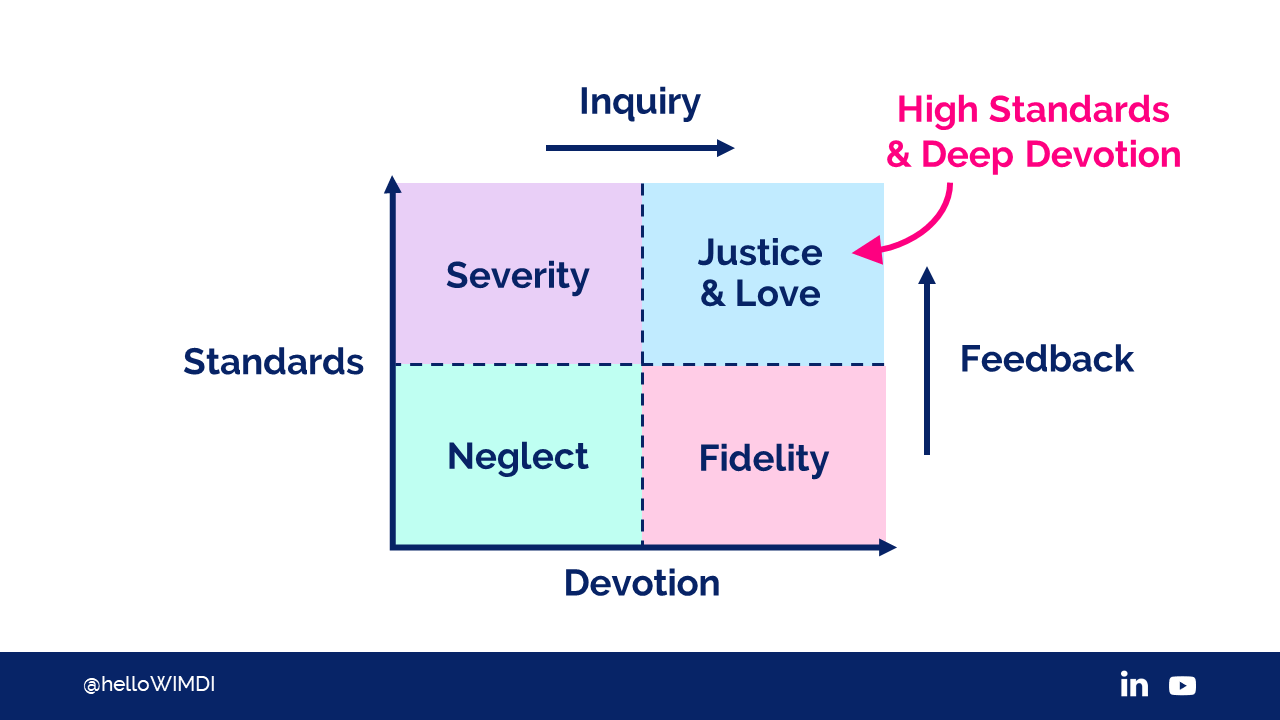
If you go up the standards axis, you're increasing the standards. But then if you go horizontally, you're showing how deeply you care for your people. They need to feel that you are deeply devoted to their success.
And if they do and you have high standards for them, you're going to grow exponentially, even if you tell them that something needs to be done, they're going to feel that you're doing that out of love, out of concern for their well-being, for their professional and career growth, et cetera.
That's how you end up in justice and love.
The question that I have for you, to take a little break from this lecture, I would like you to share in the chat, where is the default for you on the standards devotion matrix? Are you in severity? Are you being too hard on your people? Are you in fidelity?
Is there a fidelity plus? Yes, absolutely. Like it can be very, very high down on that axis, very devoted to your people with low standards.
Maybe some of you are already in justice and love. Maybe some of you folks are in neglect. I find it that I'm in neglect sometimes when the projects and the products and everything just overwhelm me, and it's easier to forget about the people.
We're going to talk now about how to move to that promised land of justice and love. And there are actually two levers that help you get there.
How to Get Out of Being Stuck in Severity
If you find yourself in severity or neglect and you want to show to increase your devotion, you're going to do that through inquiry, and I'll break that down in just a little bit.
If you want to increase your standards, you are going to do that through feedback, so let's talk about that, how to get to justice and love.
If you're stuck in Severity Land, you will need to increase your devotion, and you will do that through inquiry and positive reinforcement.
Using Inquiry to Increase Devotion (with Examples!)
Let's start first, what's inquiry? Inquiry is nothing more than just asking questions. You are showing interest in the person in what they're doing, in helping them, supporting them. So essentially, asking questions, as many questions as you can.
Remember that the currency of love is attention. There are three types of inquiry, informational inquiry, supportive inquiry, and developmental inquiry.
Informational inquiry will be questions like, "What are the top things you are focused on right now?" "Is there anything standing in your way?" "How is that particular project doing?"
So you see there, it's just getting the information. You're interested in what the person is doing currently at this point. Showing that you care, showing that you're interested in whatever it is that they're doing.
Then the next type is supportive inquiry, "How can I help you be the most successful, best self?" "How can I provide more opportunity for you?" "What can I do to unblock you?"
This shows that you are willing to give them the support that they need to show where they want to get.
And the last one is developmental inquiry, "What effect did this project have on you?" "What would success look like for you?" "When you try to expand what you're doing, are you doing it for learning or to have more influence?"
Developmental inquiry is a little bit similar to coaching. You're trying to get the person to reflect on what is happening in their career, in their minds, in anything with their life.

Take all of those three together, and the person is going to feel like you really, truly, care about what's going on with them and that you are deeply devoted to their success. That's increasing that devotion axis.
Using Positive Reinforcement to Increase Devotion (with Examples!)
The other thing you can do is called positive reinforcement. And what's that? Positive reinforcement is essentially catching someone doing something well and asking them to do more of it in the future.
It will be very, very short, usually, about 12 seconds is enough to give positive reinforcement, and you'll need to provide that all the time.
The formula for that would be to highlight achievements, then to provide specific examples of what went well. And the third step will be to encourage repetition.
Let's look at an example for this because that will make it easier to grasp and understand. "You did great in the presentation. I want to point out the three things I found exceptionally awesome."
You’re highlighting achievements, quite generally. "Your organisation was excellent." "Your slides didn't distract from your points." "You gave a clear call to action and deadline."
You're providing specific examples of what went well, very, very specific. "I'd love for you to reinforce these aspects in any future presentations and set an example to others around you."
And you're encouraging repetition here.
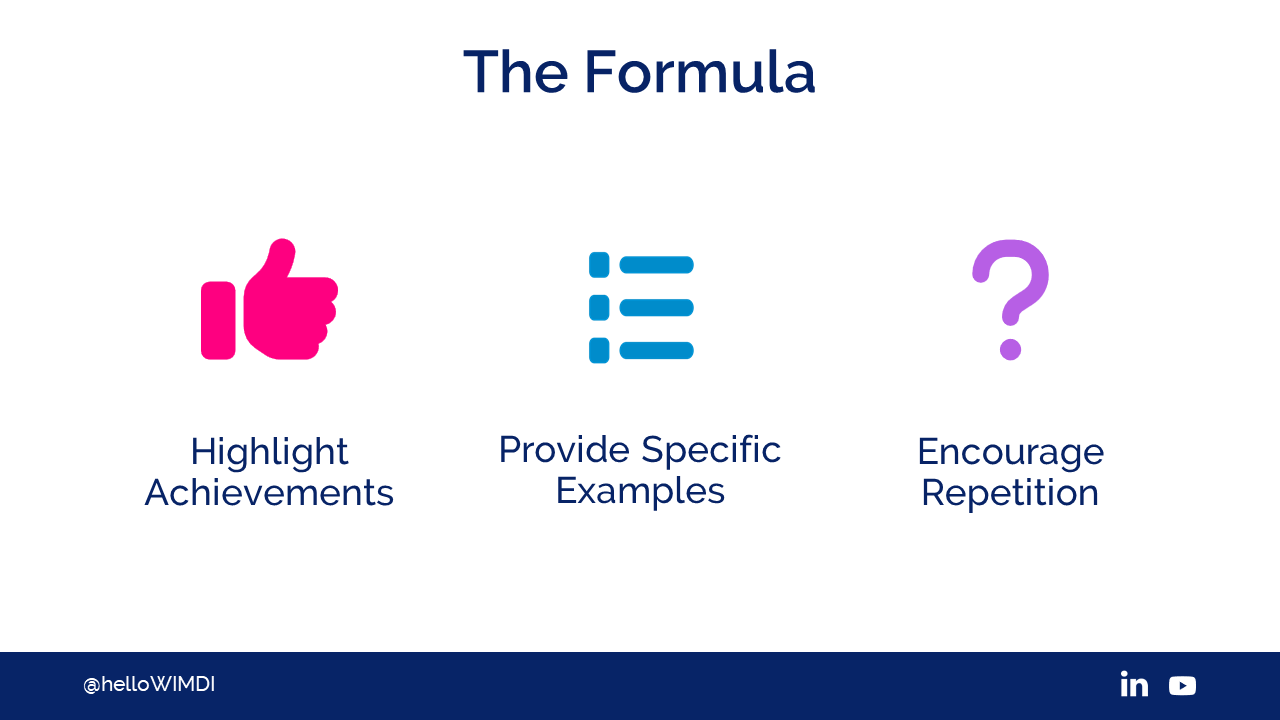
What if Your Team Member does Everything Wrong? (with Examples and Homework!)
Well, you might be asking yourself, "Okay, what if they're doing everything wrong and there isn't really anything I can find to give them positive reinforcement on?"
Here are two tips that I would have for you. The first one is to pay closer attention. There must be something that warrants repetition, maybe this is where you find yourself in neglect and not noticing the things that they're actually doing very well.
But if there's really truly nothing, nothing that they're doing well, maybe you want to try to make sure that they see you publicly giving positive reinforcement that might be useful to them to someone else.
So you're saying, "Okay, this is doing something that I want that other person to be doing." Make sure that they witness you praising that other person for that particular bit.
Here, we're going to pause for a little activity again. Please share in the chat what are some practises that you can do to show devotion. Here's some homework for you. Come up with practises to show your devotion. Three is enough.
How to Get Out of Being Stuck in Fidelity
What if you're stuck in Fidelity Land? In that case, you need to increase your standards. And how do you do that? Well, by setting clear expectations and giving feedback.
Setting Clear Expectations to Get Out of Fidelity
Let's start with clear expectations. Clear expectations are essentially telling people what you want them to do and when you want them to do it and why you want them to do it. The formula is pretty simple for those.
What you want done, when you want it done by, and why it needs to be done. I'm not going to spend too much time here because there is a actually a different webinar from WIMDI on this particular topic, it's Setting Clear Expectations as a Manager by Darrell Farrow.
Giving Feedback with The Feedback Formula (with Examples and Homework!)
Instead, we're going to focus on something that's not covered in any of the WIMDI webinars yet, at least not from this perspective, and that's feedback. What's feedback?
There's a specific formula for feedback, and it goes like this, it's five to one, that's the formula for feedback. Thank you. Thank you for coming to my talk. Goodbye. No, I'm just kidding.
The formula for feedback is, you have to give five times as much positive reinforcement as you do constructive advice. And positive reinforcement, we have already covered previously.
So now, let's focus on constructive advice. What is that little thing? Constructive advice is essentially catching someone doing something not quite right, and asking them to do it slightly differently.
Usually, at most, 10 seconds is enough to give constructive advice. You would need to give constructive advice as soon as possible, after you have noticed that behaviour that needs alteration, and it has to be very specific, it can't be judgemental, it has to be developmental.
The formula for constructive advice is going to look like this, you point out the things that should be done differently, you provide specific non-judgmental examples, and you ask to do it differently in the future.
Let's look at an example for that and practise constructive advice. An example for this is going to be me giving my friend John some feedback about his recent presentation.
I start off with, "John, I'm going to point out one thing I think you could do a little differently during your presentation," I'm pointing out the things that should be done differently.
"Your final section was, 'Vote for the puteketeke bird as the bird of the century because it is a magnificent bird with beautiful feathers and a delightful call,'" I'm providing specific non-judgmental example of what needs to be changed, "You could try rephrasing that with, 'The puteketeke bird is a magnificent bird. Its feathers are beautiful, it's call is delightful. Vote for puteketeke bird for bird of the century.'"
I'm providing a specific non-judgmental example of how it could be improved. "This way, your statement will end with a clear and powerful call to action, leaving a lasting impression on your audience. I'd like you to be mindful of what effect you would like to achieve on your audience in the future."
By this point, I know what all of you're wondering, "But what does this bird look like?" And Holly and I got you covered. Here it is. Look at that. Look at that beautiful bird. Look at that mane of feathers. Look at how it's carrying its children on its back. Look at that, it's golden hours, and it's still floating in the water.

Okay, for those of you who are not in on the joke yet, there's this comedian, John Oliver, and he recently, in true American fashion, interfered with foreign elections, this time in New Zealand. They were choosing the bird of the century.
And John put up posters in Mumbai and Tokyo, on the most busy crossings, asking people to vote for this bird. And it did win. You're looking at the bird of the century, (laughs) ladies and gentlemen. It won by landslide, got like 10 times as many votes as the 10 birds, that came after it.
Let me give you some more homework. Practise giving constructive advice at least once a week.
What's useful here is that you can actually find someone that you trust, you have a good relationship with, and tell them, "You know what? I need to practise giving this constructive advice because I'm not really good at that. Could you help me practise, please?"
Straight away, that will take some of the awkwardness out of it. And if you fail spectacularly and make them mad or something, they won't feel as bad because they know you're just practising, you're just trying it all out.
Summary
I know I gave you a lot of content, so let's try to put this all together, and I'll put this all together in a different geometric figure. I'm sure women in male-dominated industries like maths just as much as I do and love geometry just as much as I do, pretty much any talk of mine has some sort of shapes, triangles, circles, whatnot.
Well, this is the high-performance pyramid, and it goes like this, so you start with the foundation of inquiry and positive reinforcement. You ask a lot of questions to show how deeply devoted you are to a person's success, and you provide them with positive reinforcement.
You are giving them all of that positive reinforcement to make the foundation for the constructive advice that you're going to be giving them later on.
Remember that five-to-one formula. If you want to give constructive advice once a week, you'll need to give positive reinforcement once a day. If you want to give constructive advice once a month, you want to give positive reinforcement once a week, and and so on.
The key here is the fact that constructive advice needs to happen as soon as possible after that event has occurred. For that to be effective, you already need to have built up that foundation of positive reinforcement.
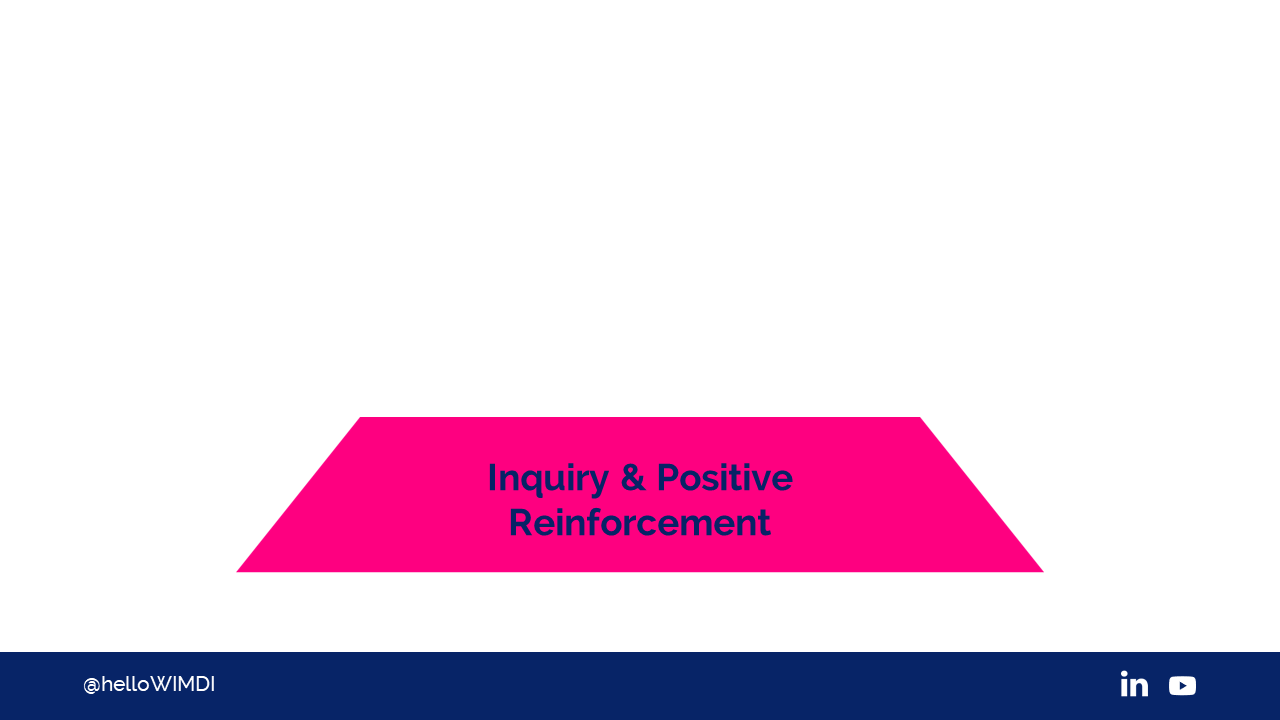
So just as much as possible, and you will have that foundation and credibility, that whenever you're pointing out something that's not quite right, it's not like your only nitpicking and noticing these small things, you're also noticing the good things.
The middle layer is the expectations, make sure to set them as clearly as possible so that people actually know what it is that you expect them to do.
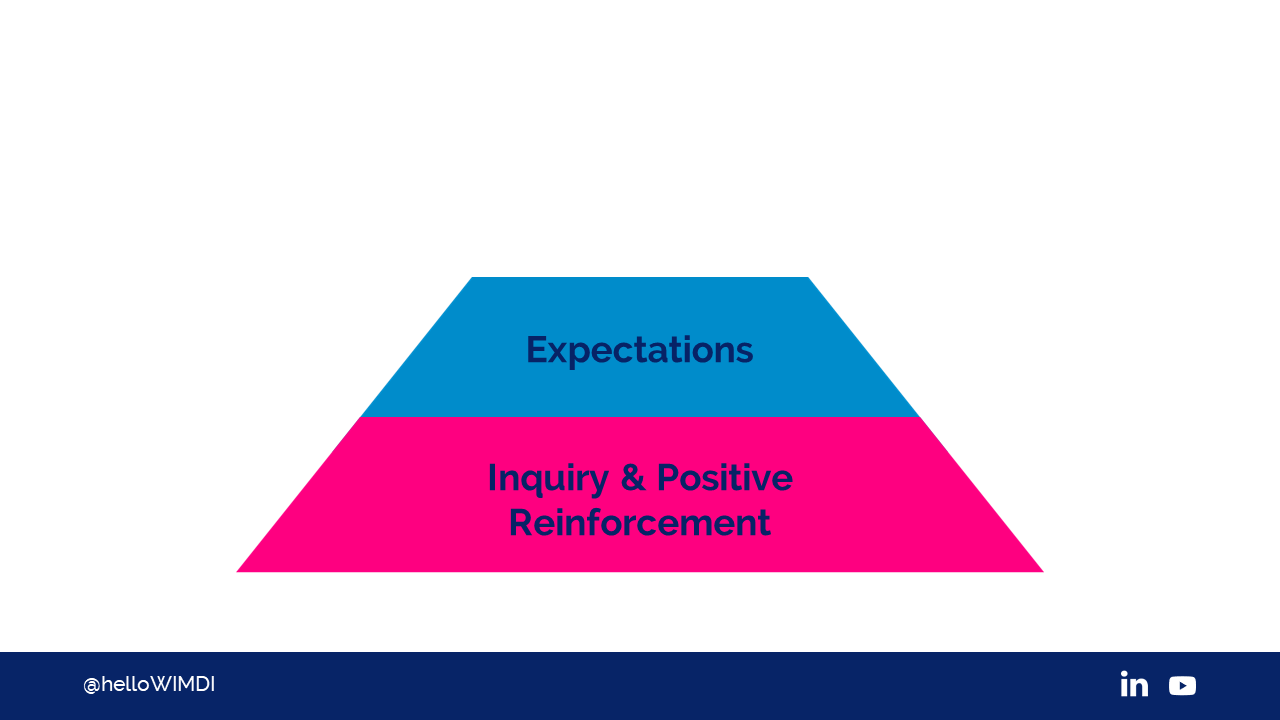
And the last bit is feedback, so, again, positive reinforcement, but also constructive advice to steer the person in the right direction.
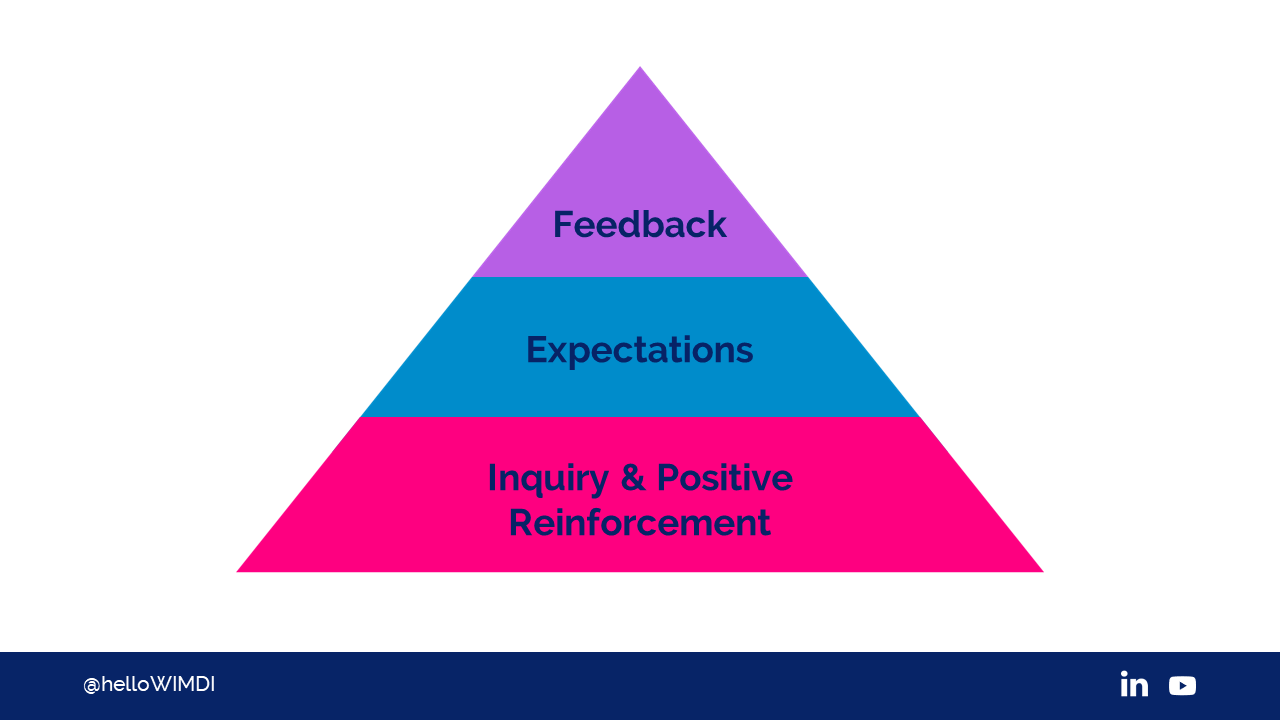
If you want to take anything out of this talk, remember these two shapes, these two shapes, the standards devotion matrix and the high-performance pyramid. Take them, memorise them, that's a good point to take a screenshot, and use them to the best of your ability.
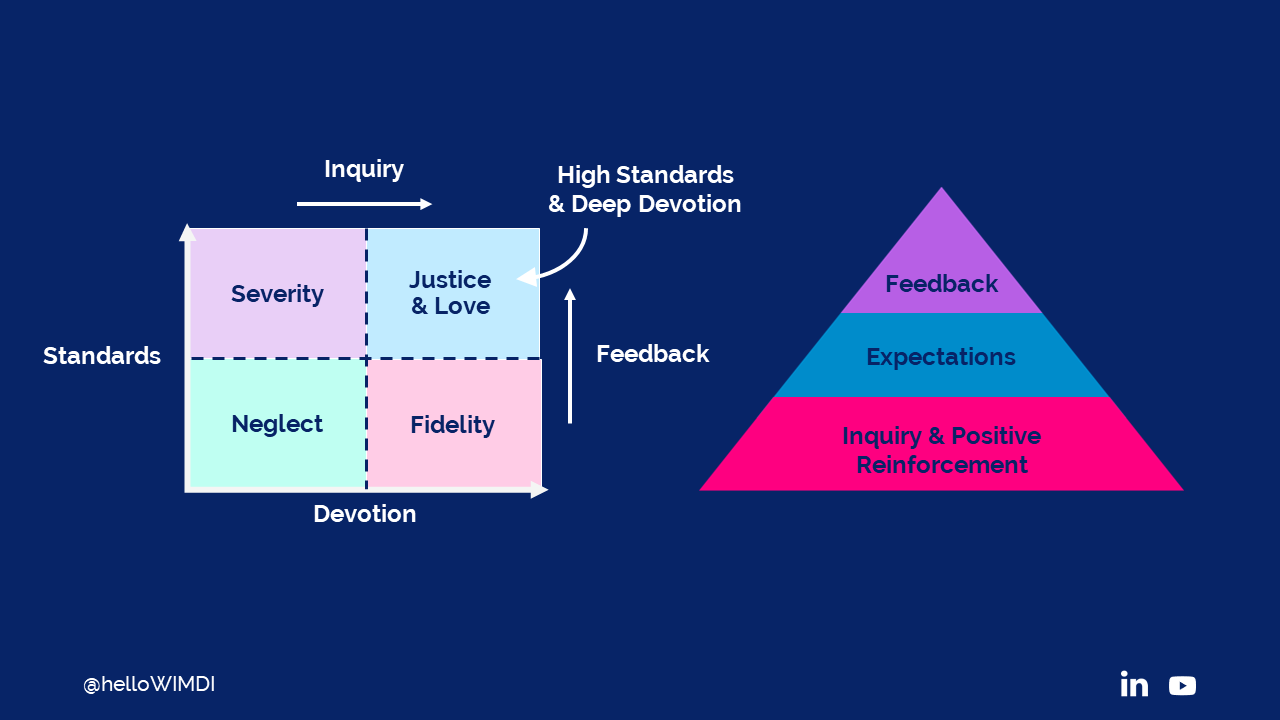
Sources
So with that, I am going to show you some of my sources and talk a little bit about those.
The standards devotion matrix actually comes from a book called "Unleashed" by Frances Frei and Anne Morris. Their work derives from Memorable Deeds and Sayings by this Roman philosopher, Valerius Maximus.
The five-to-one ratio is The Magic Relationship Ratio of The Gottman Institute, and that works not just for your professional life, it works for your personal life as well. You can try that out with your partner, with your spouse.
And then there's also Setting Clear Expectations as a Manager, which is a WIMDI webinar.
If you want some additional reading on the subject, I suggest checking out "The Feedback Fallacy" by Marcus Buckingham.
For the sake of brevity, I did not include any data from that book here, but I do recommend it as additional reading.
With that, I invite you to stay in touch with me, add me on my LinkedIn. I will try to answer your questions if you have any.
More Fun Stuff!
If you loved reading this transcript, you might like to watch the video or learn more about our amazing speaker! Check it out: